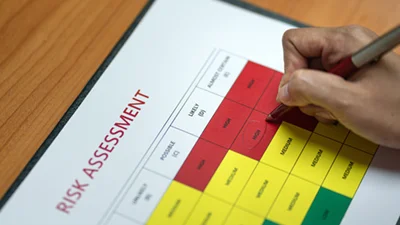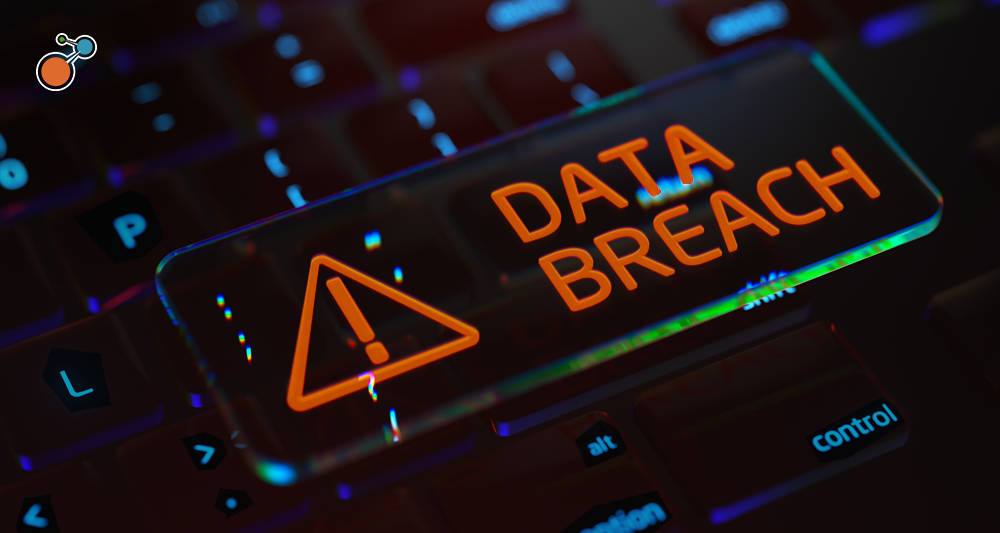When IT is at risk, it’s a priority for everyone in your business – not just the tech team. IT risk assessments help organizations identify and manage threats targeting digital infrastructure and data. While many organizations might choose to deal with IT risk through more general risk management assessments, this approach is no longer sufficient. Traditional risk assessments cover operations as a whole, whereas IT risk assessments bring necessary focus to systems and processes.
With technology at the core of modern business, understanding IT risk assessments is essential for success.
What Is an IT Risk Assessment?
 An IT risk assessment focuses on identifying threats to your information systems and digital assets. It pinpoints weaknesses in your IT processes and helps manage potential risks. To perform an IT risk assessment, you need to develop a holistic view over four major components:
An IT risk assessment focuses on identifying threats to your information systems and digital assets. It pinpoints weaknesses in your IT processes and helps manage potential risks. To perform an IT risk assessment, you need to develop a holistic view over four major components:
- Identify Potential Risks: Catalog the range of risks that can threaten your IT environment internally and externally. Draw from logs, vulnerability scans, audits, and context from other stakeholders.
- Determine Who/What Is at Risk: Map risks to specific systems, data sets, business units, and personnel. This is where cross-functional input becomes essential to paint an accurate picture. For example, if you identify a vulnerability in a database platform, consider what data it stores, which departments rely on it, and how a disruption would affect operations.
- Quantify Impact: Evaluate how each risk could affect the organization if it were realized. Impact analysis should consider operational downtime, data loss, reputational harm, regulatory penalties, and long-term business disruption.
- Review Existing Controls: Take stock of your current mitigation measures, such as firewalls, backup procedures, access controls, or training programs. Understanding what you already have in place helps determine if a risk is adequately managed.
Once you’ve worked through these core components, you can begin applying them to specific types of IT risk. These risks vary by organization and industry, but common categories include:
- Security threats like phishing, malware, insider threats, and advanced persistent threats (APTs)
- System and infrastructure failures, including outages, legacy systems, or unpatched software
- Data breaches and unauthorized access to sensitive or regulated data
- Compliance failures related to data protection regulations, such as the Health Insurance Portability and Accountability Act (HIPAA), the General Data Protection Regulation (GDPR), or the Payment Card Industry Data Security Standard (PCI DSS)
Here’s an example of how one of these risks – compliance failure – can be analyzed using the core components of an IT risk assessment:
Sample Risk Assessment Table: Compliance Failure (GDPR Violation)
| Component | GDPR Compliance Failure |
|---|---|
| Identify Potential Risks |
|
| Determine Who/What’s at Risk |
|
| Quantify Impact |
|
| Review Existing Controls |
|
What Are the Special Requirements of IT Risk Assessments?
IT risk assessments demand a level of technical depth and specificity that traditional risk processes might lack. When thinking about the contrast, three key differences stand out:
- Scope: Focuses exclusively on IT systems, infrastructure, and data
- Stakeholders: Involves IT, cybersecurity, compliance, finance, legal, and senior leadership
- Regulation: Aligns with IT-specific regulatory requirements like those from the National Institute of Standards and Technology (NIST), the International Organization for Standardization/International Electrotechnical Commission 27001 (ISO 27001), HIPAA, and GDPR
Because of these differences, it’s important to ensure the right mix of technical insight, threat intelligence, and strategy into your assessments.
Why Comprehensive IT Risk Assessments Are Crucial
Once serving as a support function, IT has become the backbone of many businesses. A single vulnerability can ripple across departments, resulting in service disruption, regulatory fines, and even existential threats to your organization. Naturally, the importance of IT risk assessments has grown alongside the complexity and interdependence of IT itself.
Operationally, planned outages and cyberattacks have always threatened core business functions. However, the attack surface has grown with the shift to remote and hybrid work. This changing landscape has added new endpoints, unmanaged devices, and shadow IT to the risk equation.
At the same time, threat actors are more sophisticated, launching APTs, supply chain attacks, and ransomware on critical infrastructure. To meet the seriousness of these threats, regulations like GDPR and HIPAA are holding companies to stricter standards. In this heightened environment, IT risk assessments are essential for all business functions.
 How to Conduct an Effective IT Risk Assessment
How to Conduct an Effective IT Risk Assessment
Conducting a thorough IT risk assessment requires a structured and repeatable process. Scheduling a regular cadence of these assessments will ensure the process is kept up-to-date. These steps outline a holistic approach to ensure risks are identified and addressed within the larger context of the business.
1. Define or Refine Your IT Environment and Assets
Make sure your IT risk assessments are up-to-date by cataloging hardware, software, endpoints, data centers, and user roles, as well as cloud assets and third-party integrations.
2. Identify Potential IT Risks
Consider both internal and external threats like cyberattacks, outdated systems, misconfigurations, and vendor vulnerabilities. Input from stakeholders will help create a complete picture.
3. Assess Vulnerabilities and Likelihood
Determine how exposed your systems are to these risks and how likely each is to occur. Use a mix of qualitative and quantitative methods like vulnerability scans, historical incident data, and expert judgement from stakeholders.
4. Evaluate Potential Impact
Estimate the business consequences if each risk materializes. Think about downtime, financial losses, reputational damage, and regulatory exposure, just to name a few. Get broad context that speaks to dangers across teams.
5. Prioritize Risks
Not all risks are equal, and every business operates with some degree of risk tolerance. Use impact and likelihood to rank them and focus your efforts on the most critical threats to your business.
6. Recommend Mitigation Strategies
Develop targeted actions to reduce or manage high-priority risks, such as technical controls, process changes, or training – whichever is most appropriate for addressing the risks at hand.
7. Document and Communicate Findings
Summarize your results in a format that aligns IT with business leadership and other teams. Make sure the assessment is clear, comprehensive, actionable, and focused on larger business impact.
Best Practices for IT Risk Assessment
To get the most value out of an IT risk assessment, organizations should move beyond treating it as a siloed technical exercise. Cross-functional collaboration can vastly improve results by ensuring a shared understanding of risks and their impacts. Risk conversations should not be limited to security incidents – they should also cover IT resilience, continuity, and the organization’s ability to recover from disruption.
Aligning IT risk assessments with broader risk management helps create consistency and makes it easier to communicate findings to leadership. Assessments should also be conducted on a regular basis, not just in response to compliance deadlines or major incidents.
Make IT risk assessments part of your everyday workflow by leveraging risk management software to automate data collection and reporting. Introducing software will reduce the manual workload of assessments, while at the same time, increasing accuracy and giving real-time insights into your risk posture.
Boosting IT Risk Assessments with Software
 Risk management software modernizes and elevates the IT risk assessment process. It gathers data from siloed systems and centralizes it, giving all stakeholders access to the same, real-time information. This maximizes visibility and creates a shared understanding of risk across your organization.
Risk management software modernizes and elevates the IT risk assessment process. It gathers data from siloed systems and centralizes it, giving all stakeholders access to the same, real-time information. This maximizes visibility and creates a shared understanding of risk across your organization.
Also, automating data collection cuts down on manual effort and reduces human error. It continually updates asset, threat, and vulnerability data, which allows you to understand your risk posture at all times. This allows teams to focus more on analysis and business strategy, rather than routine data gathering.
Integrated platforms also help companies move beyond static or periodic assessments and into real-time monitoring. Live feeds from IT environments give constant visibility to risk and enable faster detection of changes, threats, or failures. This supports a more agile, proactive approach to IT risk management, rather than one that’s just reactive.
Finally, software often includes built-in tools to map vulnerabilities to business systems and prioritize them by severity. This ensures that high-impact risks are caught quickly and assessed based on how they might affect the company more broadly, not just from a technical perspective.
Overall, software allows companies to shift from fragmented, one-off assessments to a dynamic, ongoing risk management cadence. With this new structure, collaboration is easier, insights are faster, and decisions are always aligned with business goals.
__
IT risk assessment is no longer just a task for the IT department. It’s a shared responsibility that spans entire businesses, from engineers to executives. When assessments are collaborative and supported by technology, they become strategic assets that protect your company and enable smarter decision-making.
No business will ever be 100% risk-free, but with a structured, stakeholder-driven approach to IT risk assessment, your teams can meet these threats head-on with confidence and clarity.




